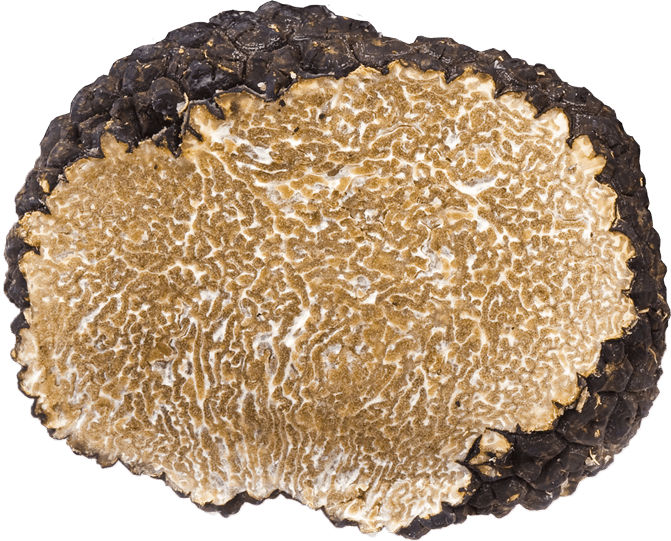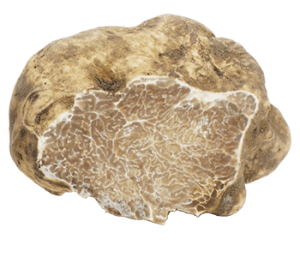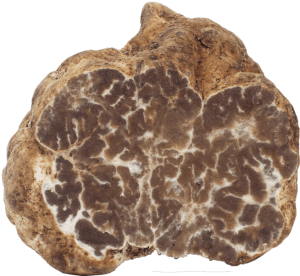What is truffle?
Truffles are subterranean mushrooms (hypogeum) species of the genus Tuber, which come in different shapes, colors and fragrances, depending on the season and ripeness. They live in symbiosis with the trees under which they grow.
Truffle is constituted by an external skin, the peridium, and by an internal mass, called gleba or pulp. There are more than 100 species of truffles in nature, among them only a few are edible and thus non-toxic.
Almost any kind of truffle has only one hunting season, but thanks to more modern preservation methods, it is possible to get the product all year long.
However, for an optimal use, it is always recommended the consumption of fresh truffle, freshly hunted or when in season.
-

Black Melanosporum truffle, truffe du Périgord

Tuber Melanosporum Vitt.
Color: black with rusty spots
Diffusion: Umbria, Marche, Lazio, Périgord
Hunting season: 15th November – 15th MarchThe dimension of this species goes from about 10 grams to 150 grams, the shape is usually rounded and regular. When it reaches the top grade of ripeness, the color on the inside becomes very dark with white-reddish filaments. The trees with which it bonds mostly are several species of oaks and pine trees. The precious black truffle is characterized by a sweet and aromatic flavour, released at its best once cooked.
-

Black Summer truffle

Tuber Aestivum Vitt.
Color: brown-blackish
Diffusion: Piedmont, Lombardy, Liguria, Veneto, Emilia-Romagna, Tuscany, Marche, Umbria, Campania
Hunting season: 1st May – 31st AugustThe dimension of the black summer truffle can reach up to 100-150 grams, though the medium size is as big as a hen egg. It is characterized by a blackish skin and the hazel inside with white veins.
The trees with which it bonds mostly are oaks, hornbeam, ash, pine, beech, hazel.
The scent of the summer truffle is very delicate with a note of porcini mushrooms and its market value is of about 1/6th of the Melanosporum Truffle. -

Black Autumn truffle

Tuber Uncinatum Chatin
Color: brown-blackish
Diffusion: Piedmont, Emilia-Romagna, Umbria, Tuscany, Marche, Lazio, Basilicata, Abruzzo
Hunting season: 1st September – 1st DecemberIts shape is slightly more irregular than the Melanosporum’s, but its aspect is pretty similar: the Uncinatum may be considered the continuation of the Black Summer Truffle, but different in flavour and with a more intense scent.
The trees with which it bonds mostly are oaks, pine trees. -

White truffle, Alba truffle, trifola

Tuber Magnatum Pico
Color: yellow-whitish
Diffusion: Piedmont, Marche, Tuscany, Emilia-Romagna, Umbria
Hunting season: 1st October – 31st DecemberNamed “The king of the table “, white truffle is considered the most precious among the edible truffles and the tastiest for most people. It can reach up to 400-500 grams of weight, tripling its value.
The colour of the skin may vary from hazel to brown to brick red. It prefers clayish and sandy soils; the trees with which it bonds mostly are: willows, oak, lindens and poplars.
It is one of the most perfumed and tasty truffles and, unlike the black truffle, is used to be eaten exclusively raw and thinly sliced. -

Whitish truffle, White spring truffle

Tuber Borchii Vitt.
Color: whitish/reddish-brown
Diffusion: Piedmont, Tuscany, Emilia-Romagna, Marche, Umbria
Hunting season: 15th January – 15th AprilThe White Spring Truffle is usually as big as a walnut, with a mostly irregular shape.
The inside is whitish, while it gets darker and gains more veins through ripeness. It usually grows in calcareous-clayish soils.
The trees with which it bonds mostly are: oaks, beeches, sainfoins, alders. Its fragrance is intense with a scent of garlic; it is best eaten raw.













